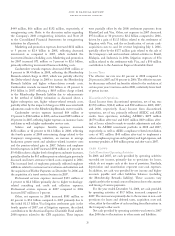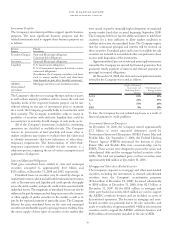American Express 2008 Annual Report Download - page 29
Download and view the complete annual report
Please find page 29 of the 2008 American Express annual report below. You can navigate through the pages in the report by either clicking on the pages listed below, or by using the keyword search tool below to find specific information within the annual report.2008 financial review
american express company
were partially offset by increased assessment revenues. Other
commissions and fees increased $184 million or 8 percent in
2007 to $2.4 billion due to higher assessments, increases in
foreign exchange conversion fees, and other service fees.
Securitization income, net decreased $437 million or 29
percent to $1.1 billion in 2008, primarily due to lower excess
spread, net, driven by increased write-offs, charges to the fair
value of the interest-only strip reflecting lower expected future
cash flows, and a net loss on sales compared to net gains in the
prior year. These impacts were partially offset by higher finance
charges and fees due to a greater average balance of securitized
loans and lower interest expense due to lower rates paid on investor
certificates. Securitization income, net increased $18 million or
1 percent to $1.5 billion in 2007 due to a larger average balance
of securitized loans, higher net gains from securitization, the
$80 million impact of the initial adoption of SFAS No. 155,
and a reduction in revenue in 2006 from higher than anticipated
cardmember completion of consumer debt repayment programs
and certain associated payment waivers. These favorable impacts
were partially offset by an increase in write-offs, a $54 million
reduction in the fair market value of the Company’s retained
subordinated interests in securitized cardmember loans, and
greater interest expense due to a higher coupon rate paid to
certificate holders.
Other revenues in 2008 increased $406 million or 23 percent
to $2.2 billion, primarily reflecting the benefits of the CPS
acquisition, higher network and partner-related revenues, a
reclassification from other commissions and fees from USCS as
discussed above, and greater foreign exchange-related revenues.
Other revenues increased $62 million or 4 percent to $1.8 billion
in 2007 due to higher network, merchant, publishing, and
insurance-related revenues, offset by a positive impact in 2006
related to the rebalancing of the Company’s Travelers Cheque
and Gift Card investment portfolio.
Interest income decreased $223 million or 3 percent
to $7.2 billion in 2008. Interest and fees on loans decreased
$192 million or 3 percent primarily reflecting a lower portfolio
yield, due to the impact of reduced market interest rates on
variably priced assets, partially offset by a slightly higher average
owned loan balance. Interest and dividends on investment
securities increased $98 million or 15 percent primarily
reflecting higher liquidity-related investment levels which more
than offset the impact of reduced investment yields. Deposits
with banks and other decreased $129 million or 32 percent as
lower yields more than offset higher deposit balances. During
2007, interest income increased $1.7 billion or 30 percent to
$7.4 billion, reflecting primarily an increase in interest and
fees on loans, which grew $1.5 billion or 30 percent due to a
29 percent increase in average owned loan balances.
Interest expense decreased $426 million or 11 percent
to $3.6 billion in 2008. Interest expense related to deposits
decreased $112 million or 20 percent, primarily due to a lower
cost of funds which more than offset increased balances. Interest
expense related to short-term borrowings decreased $248
million or 34 percent, primarily due to a lower cost of funds and
a decrease in average short-term debt. Interest expense related
to long-term debt decreased $68 million or 3 percent, primarily
reflecting a lower cost of funds driven by reduced market rates
on variably priced debt, partially offset by an increase in average
long-term debt outstanding. Interest expense of $4.0 billion in
2007 was $1.1 billion or 39 percent higher than 2006 reflecting
a $978 million increase in interest expense on long-term debt as
a result of an increase in average long-term debt outstanding in
support of growth in receivable and loan balances and a higher
effective cost of funds.
Provisions for Losses
Provisions for losses in 2008 increased $1.7 billion or 41 percent
over last year to $5.8 billion, primarily due to the difficult credit
environment, which led to increased write-off and delinquency
rates compared to 2007. Charge card provisions for losses
increased $223 million or 20 percent primarily due to higher
loss and delinquency rates compared to 2007, partially offset
by the credit-related charge in the fourth quarter of 2007.
Cardmember lending provisions for losses increased $1.5 billion
or 53 percent due to higher write-off and delinquency rates and
higher average owned loan balances.
Provisions for losses increased $1.4 billion or 54 percent in
2007. Charge card provisions for losses increased $205 million
or 22 percent due to the additional charge for credit-related
trends and higher business volumes. Cardmember lending
provisions increased $1.1 billion or 70 percent due to higher
write-off and delinquency rates, increased loan volumes, and
the charge for credit-related trends.
Expenses
Consolidated expenses for 2008 were $19.0 billion, up $1.2 billion
or 7 percent from $17.8 billion in 2007. The increase in 2008
was primarily driven by higher other, net expenses, greater
salaries and employee benefits expenses, higher occupancy
and equipment expenses, increased professional services costs
and greater cardmember services expense, partially offset by
decreased cardmember rewards expense and lower marketing
and promotion expense. Consolidated expenses for 2007 were
$17.8 billion, up $754 million or 4 percent from $17.0 billion
in 2006. The increase in 2007 was primarily driven by
increased marketing and promotion, cardmember rewards and
cardmember services expenses and higher salaries and employee
benefits expenses, partially offset by lower other, net expenses.
Consolidated expenses in 2008, 2007, and 2006 also included
27
























